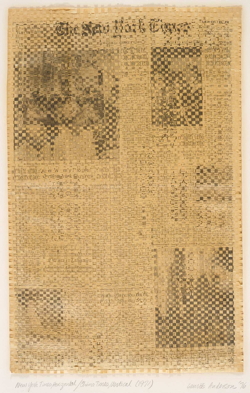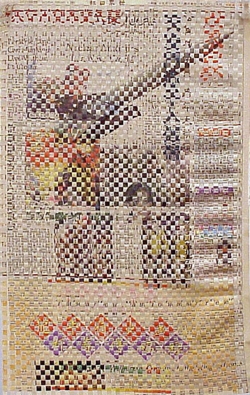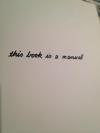listening, auditoria, audiences / écoute, auditeurs, auditoriums : — Studies —
AUDITORIAétude / studyEARLY WORKS (LAURIE ANDERSON)
|
|
Cette série explore les œuvres prenant la notion d'auditorium comme principe / This series is a study about works based on principles of auditoria. • COMPOSING THE NOW (Michel Waisvisz) - 2003 — read /lire • JULES VERNE - (Auditoires, Noise et Aventures Acoustiques / ''Audiences, Noise and Acoustic Adventures'') - XIX° — read /lire • BREATH (Gerald Shapiro) - 1971— read /lire • THE HANDPHONE TABLE (Laurie Anderson) - 1978— read /lire • LAURIE ANDERSON (Early Works 1971-1978)— read /lire • SIX SOUND PROBLEMS (Bruce Nauman) - 1968— read /lire |
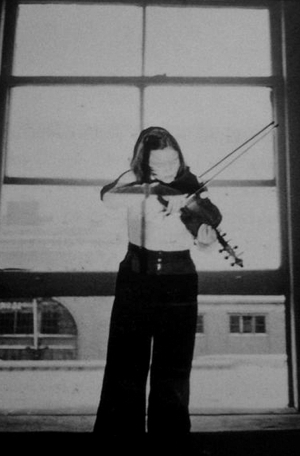
|
Page : — — [Introduction (in French)]
Pages : — — [The Handphone Table (1978)] — [Part 1 : 1971-1972] — [Part 2 : 1973-1974] — [Part 3 : 1975-1976] — [Part 4 : 1977-1978] — [Part 5 : 1979] —
(This study in five parts is in English with some excerpts in French)
— — (Cette étude comprenant les parties 1 à 5 est en anglais avec quelques parties en français)
Part 1 - 1971-1972 |
| My childhood was spent listening to other members of the family telling stories about what happened to them. We even have family songs, composed by my twin brothers. Everyone liked playing with words. — (Laurie Anderson) I was part of a group of artist/pioneers that included Gordon Matta-Clark, Gene Highstein (sic), Susie Harris, Tina Girouard, Richard Nonas, Dickie Landry, Phil Glass, Keith Sonnier and several other sculptors and musicians. We often worked on each others’ pieces and boundaries between art forms were loose… We were very aware that we were creating an entirely new scene (later known as ‘Downtown’). — (Laurie Anderson) | Laurie Anderson commence à étudier le violon à l'âge de cinq ans. Elle est née le 5 juin 1947, à Wayne, dans l'Illinois. Dans sa jeunesse, elle joue au sein de l'orchestre Chicago Youth Symphony. En 1966, elle se rend à New York afin de poursuivre des études d'art. Trois ans plus tard, elle obtient une licence au Barnard College puis, en 1972, une maîtrise à l'université Columbia. Pendant deux ans, elle enseigne l'histoire de l'art à la City University de New York. Afin de financer ses performances, Laurie Anderson collabore à ARTnews et Artforum, des revues d'art pour lesquelles elle écrit des critiques et mène des interviews. Dès 1974, elle obtient plusieurs subventions qui lui permettent de poursuivre plus aisément ses expérimentations artistiques. | Born in 1947, Laurie Anderson grew up with four brothers and three sisters in a Chicago suburb. She studied violin and played in the Chicago Youth Symphony but abandoned the idea of becoming a violinist. After her graduation in 1969, Anderson moved to New York City. In 1970 she had her first solo exhibition at Barnard College (art history studies), where she experienced also the 1968 campus revolt sparked off by the assassination of Martin Luther King Jr. At the School of Visual Arts, her teachers included Carl Andre and Sol LeWitt. In the early 1970s, while immersing herself in Buddhist texts and the writings of the phenomenologist Maurice Merleau-Ponty at Columbia University where she studied sculpture until her graduation in 1972. Anderson circulated in the downtown New York art scene, making the acquaintance of Joel Fischer, Philip Glass, Gordon Matta-Clark, Keith Sonnier and others. Her sculptures of the period were influenced by the formal idiom of Eva Hesse. Anderson wrote art reviews as a freelance critic for small art magazines in New York City, taught in schools as art history instructor at various colleges, and exhibited at various galleries and museums. Her debut as a performance artist came in 1972 in Rochester, New York, with The Afternoon of Automotive Transmission. |
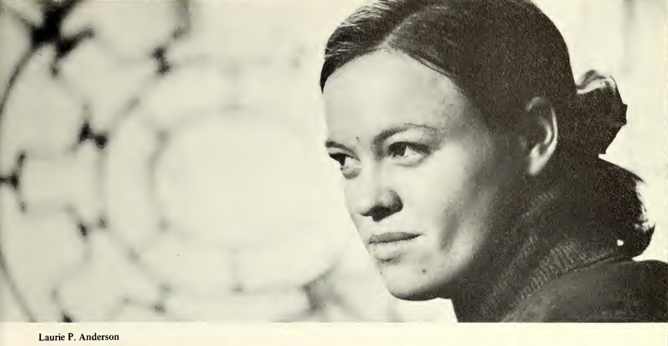
(Barnard College of Columbia University, 1969 — [Source])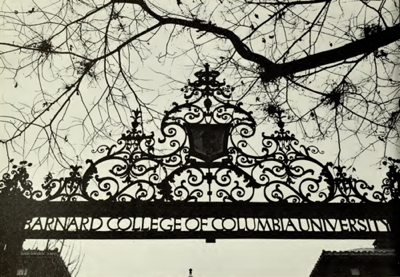
1971(Edit)
1971-1979 — New York Times horizontal/China Times vertical(Edit)
| En 1972, les premières sculptures de Laurie Anderson sont des tressages de journaux dans lesquels les trames textuelles apparaissent et disparaissent. Elle crée ses premières sculptures entre visuel et concept, dans lesquelles la structure formelle et la relation au monde sont intimement imbriquées, en tressant divers journaux (le New York Times et le Sunday pour Seven Weekends in March (1972) (composée de journaux réduits en pâte à papier, sculptés en forme en briques disposées en ligne sur le sol), ou encore le New York Times et le China Times). |
| — — New York Times, Horizontal/China Times, Vertical was constructed by weaving strips of each newspaper together. In 1972, Anderson showed a diaristic piece, Seven Weekends in March, composed of pulped newspapers formed into bricks and laid out in a line on the floor. |
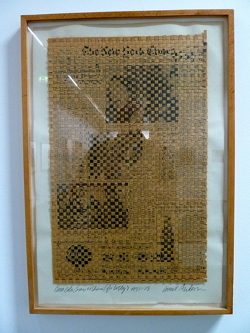 Laurie Anderson's "New York Times, Horizontal/China Times, Vertical", (Coca-Cola Comes / China (For Bobby), 1972-79) Photo : John Kannenberg Click the picture for more detail (close-up) (file : 4,3Mb) or download the picture (file : 4,3Mb) | 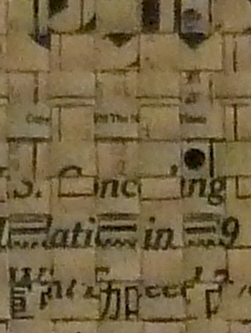 Laurie Anderson's "New York Times, Horizontal/China Times, Vertical", (Coca-Cola Comes / China (For Bobby), 1972-79) Photo : John Kannenberg Click the picture for more detail (close-up) (file : 4,3Mb) or download the picture (file : 4,3Mb) |
1972(Edit)
| -Studied Merleau Ponty with Arthur Danto, art history with Meyer Shapiro and printmaking with Tony Harrison -Learned about mudra -Spent the winter wearing no coat -Graduated from Columbia University with an MFA in sculpture -Wrote art reviews for various art magazines "Artforum," "Art News," and "Art in America" -Taught Art History at various colleges in New York City -Included in "Story Show" John Gibson Gallery -Wrote OCTOBER 1972 (published in 1976, 60 pages, Holly Solomon Gallery, New York City) and HANDBOOK -Began to work on THE TALKING BOOK -Compiled ECOTECTURAL FABLES, a series of collages about the relationship between animals and architecture |
THE TALKING BOOK (1972-...-1994) Laurie Anderson notes that Stories From the Nerve Bible (published in 1994 - the volume chronicles her works from 1972 to 1992) is here Talking Book, a project she abandoned in the Seventies : a wildly free-form anthology of stories on tape which included fragments of songs, letters, theories about motion, history, and vision. As the narrator spoke and sang, her voice constantly changed into other people’s voices. … —— "I could never really figure out exactly who was talking or how to organize this cacophonies talking orchestra. When I finished Stories From the Nerve Bible, I realized this was the Talking Book". — (In Kirstin Jean Cronn-Mills - Performance and problematization in rhetorical culture_ the example of Laurie Anderson - 1997) |
1972 — Handwriting (Mudra)(Edit)
| Toujours en 1972 Handwriting, à partir du langage des gestes bouddhiste, est une compression en papier mâché du New York Times : tous les mots sont agglomérés en un seul signe : une main qui signifie écrire. À la manière de John Baldessari et de Ed Ruscha, elle entreprendra de faire son propre papier pour ses propres livres. |
| —— The idea of Anderson as a storyteller has footing in both her live performances and her early sculptural work. While she was a student at Columbia studying sculpture Anderson began incorporating Buddhist hand gestures called “mudras” into her pieces. These gestures could have small meanings, like specific words, “writing,” for instance or larger meanings, like higher planes of consciousness. Anderson’s earliest sculptural works, such as Handwriting (Mudra) (1972) and New York Times, Horizontal/China Times, Vertical (1971), her interest in incorporating the body and language was already evident. These works were made from manipulated newspaper. Anderson created Handwriting by pressing her hand into newspaper pulp, creating a Mudra, so a Buddhist hand gesture. The pieces therefore have more than even a double meaning being highly conceptual as they are actually words (the mudras) made from other words (the printed information on Anderson’s daily copy of the New York Times). |
1972 — An Afternoon of Automotive Transmission(Edit)
| En 1972, Automotive, l'une de ses premières performances, consiste en un concert de klaxons de voitures présenté dans le parc de la ville de Rochester, dans le Vermont. |
| Rochester, Vermont - concert of automobile horns In the early 1970s, she started creating and presenting her first performance pieces such as Automotive, a “concert” of car horns in an open space in 1972. There was a symphony for car horns and autoparts entitled An Afternoon of Automotive Transmission. Renting a house in the North Hollow with downcountry friends, she exhibited her creative way of looking at things by drawing together 10 automobiles, which she called the Horn and Engine Society, and leading them in a "musical" performance that required them to blow their horns at the correct time. The concert was held Aug. 26, 1972. Despite threatening skies, the day’s program was attended by about 50 of the curious. Two other composers listed on the program that day included Peter Schneider and Geraldine Pontius. The White River Valley Herald newspaper headlined "Automotive Orchestra Bows/ In Stunning Rochester Debut," and judged that "Laurie Anderson [...] has been catapulted to recognition as the world’s foremost composer of work for automotive orchestra." "No less curious than the audience was the music," The Herald reported. "Written especially for the tonal possibilities of the autos represented, it was limited to seven notes; and because the Fords all tooted in thirds, the harmonic construction was limited." The Herald reported also that to find her orchestra, Anderson "took to the streets with a tape recorder, asking startled local motorists to toot into her machine. [...] The absense of another vehicle sent the organizers scurrying down the line of assembled spectators, blowing their auto horns until an E-natural was found and pressed into service." — (M. D. Drysdale, Laurie Anderson Gave First Concert On Rochester Park, In The Herald, Jan. 20, 2005 - [Source] — — An Afternoon of Automotive Transmission, which Anderson describes as ‘really horrible’, was her first outdoor spectacle. Performed in Rochester, New York, this happening was envisioned as a summer concert for automobile and truck horns. The whole event has a humorous tone featuring musical compositions such as: ‘The Well-Tempered Beep’, ‘Concerto for Land Rover with Six-Cylinder Backup’, ‘Six-Part Fugue for the Well-Fueled Heretic’, and ‘Auto-Da-Fé’ — “Peter Schneider, attired in a full tuxedo with black tie but without socks, directed his ‘Horn Pipe for Horn and Pipe’ while Geraldine Pontius conducted her ‘Well-tempered Beep.’” — (In Drysdale, “Automotive Orchestra Bows in Stunning Rochester Debut,” White River Valley Herald of Randolph [Rochester, VT], August 31, 1972) —. Even though mostly preoccupied with sound, this performance also inverts common spatial delineation by reversing the traditional relationship between the audience and the performers. Every summer regular musical concerts would be held in the Rochester Park, with musicians playing in the park’s gazebo and the audience seated on the surrounding grass. Also part of the local custom has been that the audience applauds the summer concerts by blowing their car horns. Anderson places the audience in the gazebo and the performers – drivers and their cars – around it. Reversing the positions and performing the concert of car horns, Anderson subverts the conventions of a traditional communal event and turns it into a happening of avant-garde defamiliarisation. — (Silvija Jestrovic, From the Ice Cube Stage to Simulated Reality: Place and Displacement in Laurie Anderson’s Performances, [Source]) — — On one level, Anderson’s Automotive reacts to the dominance of the automobile in American culture, a fact criticized and brought to national attention by Helen Leavitt’s Superhighway - Super Hoax (1970). On other levels, the piece offers a wry reply to the high culture of orchestras and to a regular local event in Rochester. During Sunday evenings in the summer of 1972, the town of Rochester convened on its town green. The high school brass band played in the gazebo, while the audience parked their cars around it and sat there to hear the show. Anderson explains, "The strange thing was that they never got out of their cars. After each number, they honked their horns as applause […] The applause sounded better than the concert". Inspired by the "rich, resonant, loud" sounds of the horns, she decided to write a piece for car horns. Anderson auditioned local owners of cars, trucks, and motorcycles — If you would like to participate in the first Automotive Orchestra please call 767-5331. (No previous orchestral experience necessary). We hope to rehearse and perform this piece soon so please call before August 20. —, and Automotive was performed on Sunday evening, 27 August 1972, on Rochester’s green. She reports, "The concert was performed on the town green but this time the relationship was reversed : the audience sat in the gazebo and the orchestra surrounded it. […] On of the pieces sounded more or less like barking seals but another had the magnificence of an enormous traffic jam" (Laurie Anderson, In Stories from the Nerve Bible) — (Philip Nel, The Avant-garde and American Postmodernity, University Press of Mississippi, 2002) |
| It sounded great. WBAI has broadcast it a few times. I sent them a tape after the concert and said, Here are some nice cars in harmony. If you ever want to play it, you can. — (Laurie Anderson, Interviewed by William Duckworth) |
1972-74 — Chord for a Room(Edit)
— — April 18-19-20-21, 1974 - About 405 East 13th Street (#2), organized by Jean Dupuy
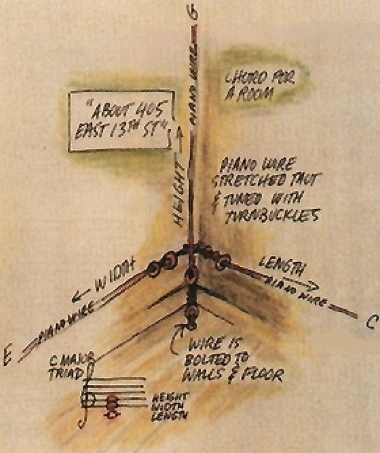 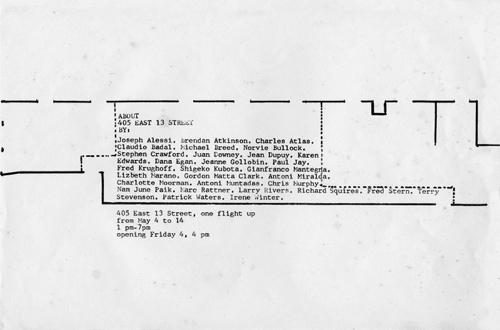 Flyer, About 405 East 13th Street#1, 19,8 x 30 cm, mai 1973 — — — — In a number of works, such as Chord for a Room (1972) and The Window, The Wind, Oh (1976), Anderson incorporates architectural elements to produce sound. Chord for a Room was conceived for the Jean Dupuy's exhibition "About 405 East 13th Street #2", in 1974 — [About 405 East 13th Street #1", 1973]. — — (In 1972, Dupuy left his gallery to live as a form of art, free of the constraints of the art market. Seeking to work outside of a market that he felt reduced artistic objects to a base monetary value, he began exploring intangible, ephemeral approaches to performance and experiential practice. A year later he held his first collective event, "About 405 East 13th Street (#1)", where 30 artists participated. Dupuy considered collective work to be a “sampling of contemporary creation” and considered the mix of artists involved to be like a salad, each bringing their own unique voice and creative abilities to the mix. In 1973, Jean Dupuy invited thirty-four artists to participate in the exhibit. The aim of this collective project titled “About 405 East 13th Street #1”. was to intervene, modify or document the interior and exterior spaces of Dupuy’s loft –following a process that he termed as “spatialisation”. In critic Laurie Anderson’s words, it explored the “description and manipulation of several interior, exterior, and interfacial aspects of the loft. The microscopic and telescopic realignments destabilized the conventional subject-object relationship.” (Laurie Anderson, “Spatializing, About 405 # 1” In Art Forum, September 1973, pp. 88-90). As an example, Gordon Matta-Clark, one of the invited artists, proposed to simply clean one of several window’s pane of glass, thus subtly modifying the relationship between interior and exterior spaces, a gesture that ensured the introduction of light. — (In Xavier Costa, Moments and Situations: The Pavilion and Its Archive, Northeastern University) — — For the second year in a row, a show called About 405 East 13th Street has been held at 405 East 13th Street, in the loft of Jean Dupuy. Unlike the majority of independent exhibitions tied to no gallery or institution, which generally show the work of a single individual, this is a group show including the works of some 38 persons, six of who live in the building, the rest artists who nonetheless have addressed themselves to the building/loft. […] The idea of Laurie Anderson - to stretch tension wires from floor to ceiling in such a way that each wire across the length and width of the loft [of Jean Dupuy] at the ceiling in such a way that each wire would resonate on a different tone when plucked, based upon the dimensions of the loft - was in theory a fine adaptation to the space. —(P.I. Greene, About 405 #2, In Jean Dupuy, Collective Consciousness, Art Performances in the Seventies, Edited by Jean Dupuy, Performing Arts Journal Publications, New York, 1980, p.115) 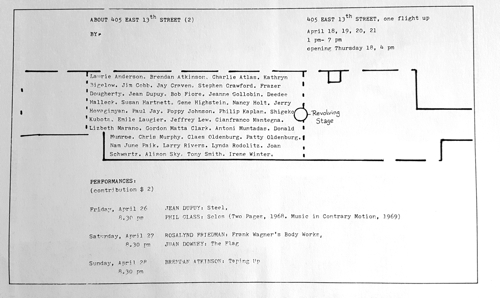 Flyer, About 405 East 13th Street#2, april 1974, In Jean Dupuy, Collective Consciousness, Art Performances in the Seventies, Edited by Jean Dupuy, Performing Arts Journal Publications, New York, 1980, p.112) | Dans plusieurs de ces œuvres dont Chord for a Room (1972) et The Window, The Wind, Oh (1976), Laurie Anderson incorpore des éléments architecturaux pour produire du son. Chord for a Room a été conçu pour l'exposition organisée par Jean Dupuy à New York en avril 1974, About 405 East 13th Street #2 — [About 405 East 13th Street #1] — [About 405 East 13th Street #1 - page 2] — Jean Dupuy organise, en mai 1973, son premier événement collectif, une exposition, « About 405 East 13th Street (#1) », pour laquelle il invite trente artistes à intervenir dans et à propos de son lieu (un loft, espace à la fois de travail et de vie) : des interventions minimales, imperceptibles, pour la plupart, où les œuvres présentées ne sont pas à vendre. Les événements « About 405 East 13th Street (#2) » et « About 405 East 13th Street (#3) » se dérouleront en 1974 et 1975. Par exemple en avril 1975, le Philip Glass Ensemble joua Two Pages et Music in Contrary Motion, deux œuvres de Philip Glass). Pour l'événement « About 405 East 13th Street (#1) » Laurie Anderson écrit un article dans Artforum Spatializing. — — En 73, le marché de l’art dépassait toute mesure, c’est le moins qu’on puisse dire. En 1973, j’organisais, en invitant trente-quatre artistes (deux générations), un show collectif, chez moi, au sujet de mon loft 405 13th Street situé près du ghetto portoricain. Rien n’était à vendre. Lors de la première expo [il y eut deux autres sessions #2 et #3 les deux années suivantes], une partie des oeuvres faites in situ, était quasi invisible. Par exemple, Lizbeth Marano avait collé sur la porte d’entrée, une réplique photographique à l’échelle 1/1, de la porte d’entrée. Gordon Matta-Clark avait lavé un carreau d’une des huit fenêtres – ça n’avait jamais été fait depuis cent ans – situées côté Ouest. Antoni Muntadas a rempli quatre tiroirs d’un meuble, de produits naturels odoriférants pris dans le quartier. Nam June Paik projeta une vidéo du plafond sur le plafond. Richard Squire suspendit dans l’espace la maquette du loft faite à l’échelle 1/20. Irene Winter accrocha une terre cuite (2 000 B.C.) sur le mur en brique (2 000 A.C.). Chris Murphy fit un calque du plafond pour le coller au plancher. J’ai ouvert le plancher pour voir le dessous, et le plafond, le dessus. Gian Franco Mantegna montra des photos et des affiches rapportant des scènes de mai 1968, à Paris, prises cinq ans avant. Charlotte Moorman vint de temps en temps dans le loft pour jouer en play-back une partita de violoncelle, avec un masque de Pablo Casals sur le visage… et cætera. Trente-quatre oeuvres, et même un peu plus, éphémères et pas signées. La peinture brillait par son absence. Les artistes ont dû, à tour de rôle, faire les guides pendant les huit jours de l’expo, pour signaler aux visiteurs ce qui était invisiblement exposé et donner le nom des auteurs. La presse fut étonnée : tout était contraire aux galeries de SoHo. Artforum, représentant pourtant « The art business », a publié un article très descriptif de quatre pages signé Laurie Anderson sur cette première expo et l’année suivante, sur la deuxième, un article de Alan Moore. Le troisième et dernier opus de ce festival se passa chez Jayne Bliss, au quatrième étage. — (Jean Dupuy, Extrait de l'entretien avec Éric Mangion paru dans le catalogue de l'exposition À la bonne heure, Semiose éditions / Villa Tamaris Centre d'Art / Villa Arson Nice, 2008) Pour la deuxième année consécutive, une exposition intitulée About 405 East 13th Street a eu lieu au 405 East 13th Street, dans le loft de Jean Dupuy. Contrairement à la majorité des expositions indépendantes organisées en dehors du circuit des galeries et des institutions, qui montrent en général le travail d’un seul individu, il s’agit d’une exposition de groupe présentant les travaux de trente-huit artistes. Six vivent dans l’immeuble, mais les autres ont également travaillé sur la spécificité de l’immeuble/loft. […] L’idée de Laurie Anderson - tendre des fils métalliques du sol au plafond, et de long en large du loft au niveau du plafond, de telle sorte que chaque fil résonne sur un ton différent lorsqu’on le pince, selon les dimensions du loft - était, en théorie, une excellente façon de s’adapter à l’espace. — (P.I. Greene, About 405 #2, In Jean Dupuy, Collective Consciousness, Art Performances in the Seventies, Edited by Jean Dupuy, Performing Arts Journal Publications, New York, 1980, p.115) |
(Laurie Anderson, “Spatializing" (About 405 # 1), In Art Forum (September 1973) ; and In Jean Dupuy, Collective Consciousness, Art Performances in the Seventies, Edited by Jean Dupuy, Performing Arts Journal Publications, New York, 1980, pp.100-103) | |||
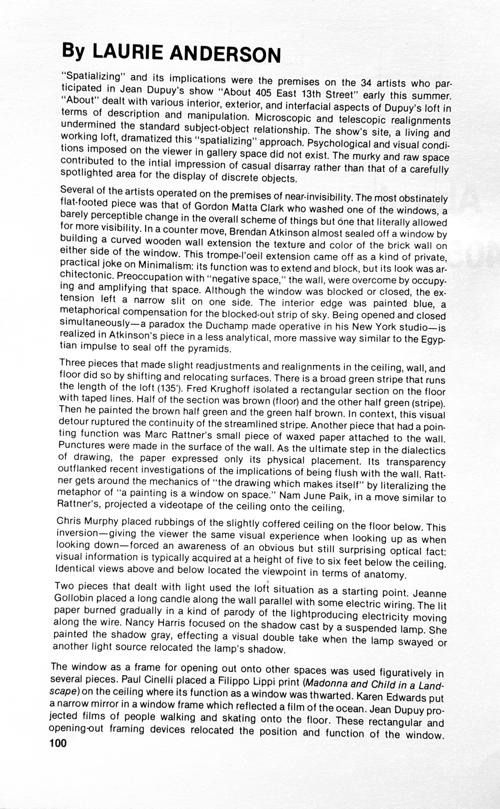 |  | ||
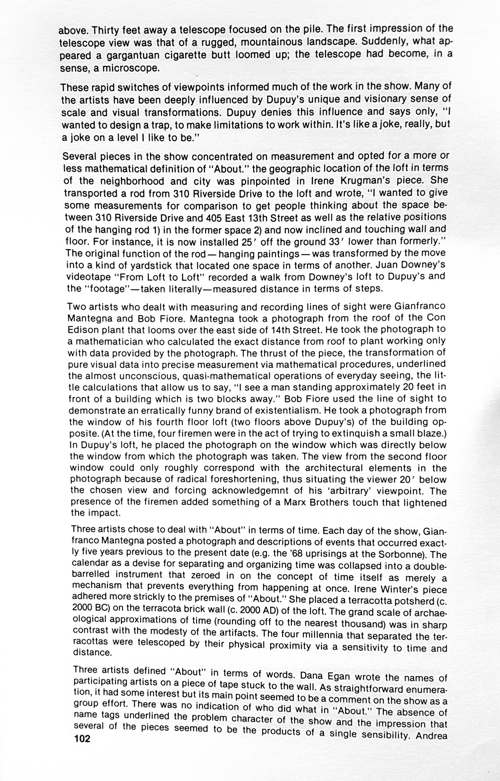 | 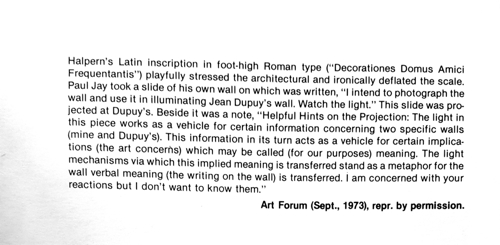 |
Next Part 2 : 1973-1974(Edit)
Pages : — — [The Handphone Table (1978)] — [Part 1 : 1971-1972] — [Part 2 : 1973-1974] — [Part 3 : 1975-1976] — [Part 4 : 1977-1978] — [Part 5 : 1979] —
Page : — — [Introduction (in French)]
